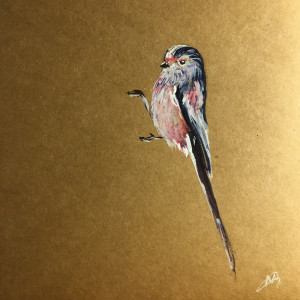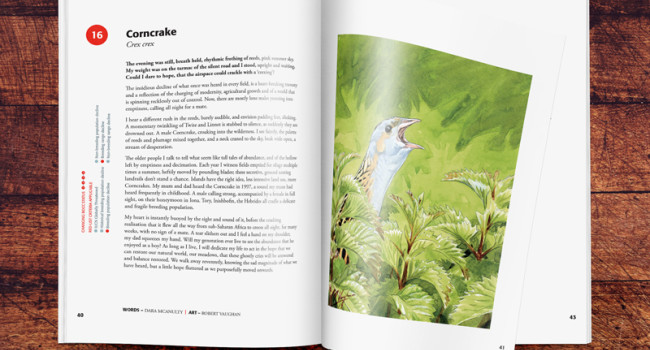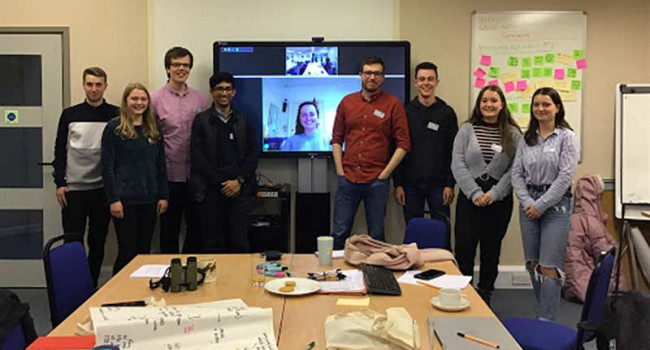
Exploring Birds through Art
Birds have been depicted in art since prehistory, from Neolithic cave paintings to modern identification guides. More recently, art has been used to draw attention to the plight of wildlife in works such as Red Sixty Seven, a collection of visual and written art celebrating Britain’s most vulnerable bird species. As a new generation of young birders joins BTO, the representation of birds in art continues to evolve. Alicia Hayden, BTO Youth Advisory Panel member, writes about her love of birds and art, and how they coalesce in her growing portfolio.
My Volery
A softness.
Their twinkling cheeps and chirps
As they hop from branch to branch,
Scattering rain droplets like leaves in Autumn.
Together.
They huddle so close, so tight
That you can feel their warmth,
The pink blush on their chests almost glowing.
Light.
As a feather. They move like
Dolphins leaping through frothing waves,
Like salmon of the skies.
And now they perch on trees laden full of food,
My feathered family - my volery.
Alicia Hayden
Flights of fancy
Since I was little, I’ve always wished I could fly like a bird.
One of my favourite animals is the Arctic Tern because they get the best of all worlds: they can dive into the ocean, fly through the sky, and rest on land. They’re also so elegant, like angels of the ocean, and exceptional fliers – covering an estimated 25,000 miles per year during their annual migration. I would give anything to experience the world as they do.
However, I can’t fly like a bird, so I’ve found that the next best way for me to explore the lives of these extraordinary creatures is through art. Of the many different types of art my favourites to work in are visual and written forms – especially drawings, paintings, and poems. I like merging my love for the arts with my love for the environment and science to show the general public the beauty of the natural world, and demonstrate the reasons we need to protect it.
Lockdown slowdown
During the first lockdown in 2020, I immersed myself in nature even more than usual.
Living in North Yorkshire, my walks have always been nature-filled, but the stress of lockdown meant I slowed down during these moments and really listened to the birds around me.
Over the summer, I followed a family of Long-tailed Tits, seeing them every evening at around 7 pm in June and July – it filled me with joy whenever I heard their sweet pissp-pissp-pissp, and I was constantly trying to photograph them. I find Long-tailed Tits are particularly charismatic birds, and I quickly started sketching and writing about them after my walks.
My Volery is written about this family; “volery” is the collective noun for Long-tailed Tits, which I think fits their sweet persona well. Like most of my poems, I wrote My Volery while out in the field, as I am particularly inspired by my experiences in nature.
Art is such a personal process – laying your thoughts and emotions bare for others to view. I am always most nervous about sharing my poetry, perhaps because it feels the most intimate art form – like I’m speaking directly to the reader. I think poetry can be a powerful way of drawing attention to species and ecosystems, and I hope that when people read my work, they feel inspired to connect with nature.
Discovering birds through artistic media
When I create visual art, I love to experiment with different media, and I think this helps me explore birds more deeply; when I use different materials and techniques, I focus on different characteristics of the species I am depicting.
One of the first media I used to sketch birds was biro. I enjoy the precision it allows, and I also like the depth and shade I can achieve – I find it particularly effective for fine feathers and smooth surfaces like beaks.
I’ve also started to work with coffee, which I find works particularly well for birds with hues of brown and gold, such as Hen Harriers and Ospreys. Drawing with ink pens allows me to retain detail while the coffee gives more tone and creates light and shade in my bird sketches. The overall effect is a simplicity which I think makes the pieces more dynamic.
Goldcrest (Biro)
Osprey (Coffee and Ink)
Sarus Crane (Acrylic Inks)
Art may be passive compared to more practical methods of conservation, but it can be a powerful way of connecting with new audiences.
More recently, I have been working in acrylic inks to explore the world’s most colourful birds, from the more exotic Sarus Crane to birds with beautiful plumage within the UK, such as the Long-tailed Tit.
The aim of my plumage series is to focus on the diversity of bird feathers – so I’ve been working with acrylic inks to emphasise the colours, patterns, and textures. Acrylic inks are so vibrant, and while working on this series, I’ve purposefully limited myself by not using black ink and created dark colours using purple, blue, red, and green. Reducing my colour palette means I have paid more attention to the incremental colour changes within birds’ plumage, which hopefully makes my paintings more accurate as well as detailed!

Art as activism
As well as depicting the beauty of birds, in my wildlife artivism work I try and explicitly illustrate how anthropogenic activities are negatively impacting the environment. I hope that this work makes people stop and think, and that my art will ultimately inspire change. Art may be passive compared to more practical methods of conservation, but it can be a powerful way of connecting with new audiences.
With all my work, be it visual or written, I aspire to instil a curiosity for discovering birds in my audience, and a desire to protect them. These days, it is so easy for people to become disconnected from nature by spending an increasing amount of time on digital devices – I hope that if people come across my work, it will inspire them to head outside to explore the natural world for themselves, and experience the beauty of birds.

Young people are the future of BTO
With your help, we can do more to reach out to, connect with and support them.
Donate to the BTO Youth Appeal today











Share this page